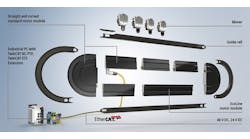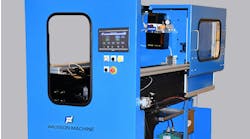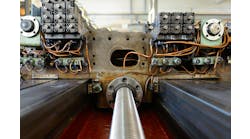Mike Bacidore is the editor in chief for Control Design magazine. He is an award-winning columnist, earning a Gold Regional Award and a Silver National Award from the American Society of Business Publication Editors. Email him at [email protected] or check out his Google+ profile.
Sometimes, choosing a component is up to the customer’s discretion. Sometimes, it’s based on the application. And sometimes it’s just what the machine builder is most familiar with. With relays, there are a few clear-cut ways to go, but many times it’s a matter of trade-offs. Choosing between electromechanical relays (EMRs) and solid-state relays (SSRs) is sometimes more difficult than you get credit for.
This panel of industry veterans will give you a few insights that might remind you of some basics you already know and could help you make a more-informed decision on your next machine.
Meet the panel
In which applications are electromechanical relays (EMRs) still more advantageous than solid-state relays (SSRs), and why?
Stevic: EMRs have several distinct advantages over SSRs when it comes to the power/cost ratio, switching voltage capabilities, power dissipation characteristics and failure mode. An EMR with a rating of 30 A can be had for as little as $10, where an SSR of the same power handling capability will cost about four to five times as much.
An EMR can switch 440 Vac or 24 Vdc without any change in design. Switching very small voltages often requires special contact construction such as gold plating, but for most industrial applications, general purpose relays work fine.
When an EMR switches off, the stored power in the load needs to be dealt with in some manner. Surge-suppressing devices like MOVs, varistors, RC circuits or, for dc applications, diodes can be used to channel the energy stored in the load, but, for many applications, just opening the contacts and letting the energy spark between is quite often an acceptable solution. The decision as to whether to use spark-suppression circuits is usually a matter of the relay duty cycle. A power circuit that cycles every few seconds or minutes will last considerably longer with suppression control. A power circuit that has an on-off duty cycle measured in hours or more may not show any benefit from a longer operating life. An SSR may or may not require external suppression, but, for higher currents, it is a best practice to use a heat-sink device to remove the operational heat generated by the relay. The heat production of an SSR might also be a consideration when designing a circuit that will operate in high ambient temperature conditions.
Not always, but in my experience, when an EMR fails, it typically fails in an open circuit condition. The open circuit can be due to the coil failing, the mechanical spring on the contacts failing or the contact material becoming corroded or pitted and failing to make a good electrical connection. In some cases, the contacts will become welded closed and the failure results in a closed circuit. SSRs on the other hand typically fail in a shorted condition, allowing the power circuit to remain energized even when the control voltage is removed.
Also read: In With SSR? Out With EMR?
Collins: I am not an electrical engineer, but I will tell you what I remember from my role as general manager. The biggest problem with solid state relays is that they have the possibility of shorting out in the "on" stage. The disadvantage of electromechanical relays is that they wear out faster than SSRs.
Bretz: Electromechanical relays are generally the top choice for applications on a budget. They generally cost less because they have a life expectancy. Solid-state relays virtually last forever, if used with in specs, and normally cost more for this reason. Electromechanical relays are available in many voltages and could have from one up to four sets of contacts/poles in one relay housing. Therefore, one electromechanical relay could switch up to four different loads. Solid-state relays are limited to one load, as they only have one set of contacts. Electromechanical relays have contacts that open and close, turning on or off the circuit to the load. EMRs are generally selected for applications that require the circuit to be completely on or off, without any leakage current. In solid-state relays, the contacts are switched with a semiconductor, and off-state leakage current is possible.
Frauton: Mechanical contacts have much wider compatibility with different load sizes. You could, for example, send a low-voltage, low-current signal as input for a PLC or, with the same EMR, transmit 250 Vac, 10 A of power. With SSRs, on the other hand, different models are required for different loads. EMRs are what are known as dry contact. There are no power leakage issues with the EMRs. They are either fully open or fully closed. SSRs, in contrast, have some leakage in both directions. When they are open, they are not fully open; when they are closed, they are not fully closed, which results in some dissipation of energy.
Nigro: EMRs are still more advantageous in applications where space is very limited and heat buildup in a panel is a concern. EMRs are still more advantageous due to extremely low metal-to-metal contact resistance than SSR—thus, very low heat buildup on the contacts. This allows EMRs to have a smaller profile than an SSR with the correct heat sink applied. EMRs allow either ac or dc loads, whereas SSRs need to be specified and ordered based on the load. Typically EMRs are lower in cost than a SSR. EMRs are offered with multi-pole configurations along with normally closed contacts. EMRs have no off-state leakage current to deal with.
Lockhart: Any application where it is desired to have closed contacts in the absence of power. SSRs appear to only have closed contacts when the input is energized. EMRs can do multiple contact functions more easily—for example, DPDT. EMRs can handle both dc and ac loads in one relay. EMRs have no ac leakage current in the off state, unlike many ac SSRs, which have RC snubbers built in. EMRs don’t need heat sinks. And EMRs can also have lower on-state voltage drop.
Harmon: With continued advances in the designs of solid-state and electromechanical relays, it is becoming more and more difficult to select the right relay for a particular application. Solid-state relays are taking advantage of innovations in packaging, internal bonding and thermal management to increase their performance and reduce their size. Similarly, electromechanical relays are utilizing new materials and mounting options to increase load ratings and simplify installation. While the technologies used in the design and manufacturing of these components greatly differs, it’s the unique advantages of each that ultimately help customers decide.
Edwards: EMRs still have an advantage over SSRs in applications like motors and transformers that require high starting Amps.
Pabich: EMRs are advantageous in lower amperage applications and where loads are being switched infrequently. EMRs typically offer lower initial cost. However lifespan cost of a relay has to be evaluated carefully. In a typical application, EMRs have to be replaced more often than SSRs.
Massie: EMRs are still preferred for many applications due to their wide output range. For example, one EMR can switch from 50 mA to 25 A ac and dc. Switching the same range of loads would require three or four different SSRs with different output devices. For example, you would need a Triac, thyristor or back-to-back SSRs for an ac load, and a transistor, SCR or MOSFET for a dc load.
Also, cost is big factor, as the SSR is typically double the cost of the equivalent EMR. EMRs have slight edge in terms of ambient temperature, since the SSR’s semiconductors must stay with thermal limits. The limit for EMRs is the temperature rise of the contacts and coil temperature because the relay coil’s resistance will go up 0.39% per °C. Typically, both EMRs and SSRs must be de-rated at high ambient temperatures.
Since relay contacts are silver alloys, the on resistance is less than 50 mΩ, and closer to 10-25 mΩ initially; this results in cool operation when compared to an SSR. For the above reason, EMRs don’t need heat sinks.
Finally, SSRs have limited pole configurations. For the most part, SSRs are SPST (form 1A normally open), where EMRs come in many configurations from one to six poles, multiple throws and a combination of normally open and normally closed throws. For example, a force-guided EMR is available with six poles, which are a combination of normally open and normally closed contact sets.
Wadowick: EMRs are often more advantageous in the case of higher value voltages, or perhaps “odd value” voltages, and certainly at times when higher current is needed. Furthermore, in the case of maximum signal isolation, relays remain the preferred method to achieve the highest level of electrical isolation.
Weiss: EMRs are more advantageous than SSRs in the HVAC unit in the home and in the thermostats in the home as consumers like to hear the click of the relay that comes with EMRs. This way, they are confident the units are working properly; the click gives the consumer the assurance all is well.
Where does it make better sense to use SSRs, and why are they a better fit than EMRs in certain applications?
Kirk: We had a job last year with Pom Wonderful, and we used an SSR with an electric shell heater. The heater was used for a continuous spray system, and originally it had its own thermostat. The thermostat could not keep the desired range, so we used an SSR and a PID loop to control it. The solutions worked well.
Stevic: SSRs are best suited for high-speed switching applications such as heating circuits. EMRs all have a rated life cycle of x number of switching operations. In solid-state relays, this rating is many times higher as there are no mechanical moving parts to wear out. SSRs are also likely a better choice in high vibration applications, if the device is designed for such applications.
Massie: SSRs are great for high-repetition type loads such as molding machinery and solenoids for manufacturing machines. In molding, the temperature controller is constantly turning the heaters on and off, using PID or other type of control. Thus, the relay will require a life well over 1 million operations. Typically, EMRs are only rated for 1 to 50 million mechanical operations at no load.
A pneumatic solenoid control may need to operate every five seconds, nearly 5,800 operations in an eight-hour shift. Unless one uses a major “overkill” EMR, quite large and expensive, the SSR will perform better. Overkill means, for example, using a 15-A relay for a 500-mA solenoid.
Since SSRs have very little electrical noise, this is a benefit when the relay is used near sensitive automation components such as PLCs, HMIs, smart relays, temperature controllers and other controllers.
SSRs have a benefit when used in an environment with a great deal of shock and vibration; this would include transportation applications such as trains, buses, planes, trucks and cars. While SSRs are great, most SSRs in industrial systems are panel-mounted in fixed positions.
Lockhart: SSRs have an advantage in applications where there will be frequent on-off cycling. Unlike the electrical and mechanical life limits of EMRs, they have very long cycle life. SSRs don’t have contact bounce.
Bretz: Solid-state relays are the preferred choice for system reliability because they have no moving parts or contacts. Over time, the plating on the contacts inside EMRs can erode. This erosion can cause the contacts to weld shut; therefore they no longer open/close properly, and the relay has to be replaced. Solid-state relays do not have contacts; therefore this contact erosion is not a problem. Solid-state relays can virtually last forever, if used within specs. Solid-state relays do not have any moving parts; therefore they are not affected by physical shock and vibration, making them the ideal choice for high-vibration applications and environments. Solid-state relays operate silently and produce little electrical interference. They are selected for quiet operation, because they do not make noise when the output contacts change states. Electromechanical relays create electromagnetic noise, because of contact arcing and can create interference in the power lines.
Pabich: The main advantage to using SSRs is their longevity. The typical electrical life of a small EMR is 100 K switching cycles, while electrical life of an SSR is in millions, assuming an SSR is properly applied. SSRs should be used in applications where load has to be switched frequently or for extended periods of time.
Wadowick: Traditional electromechanical relays have some noteworthy problems inherent to their design: switching speed and the fact that the number of switch cycles the device can perform over its lifetime is quite low when compared to solid-state electronic equivalents. EMRs are also large and expensive devices compared to their solid-state cohorts. The advent of power MOSFET (metal–oxide–semiconductor field-effect transistor) technologies has greatly improved the competitive advantages of solid-state devices compared to the mechanical relays because the on resistance is so low—only a few milliOhms—and the off resistance is so high—hundreds of megaOhms. The device is, for all practical purposes, a very close approximation to the mechanical switch in its electrical properties. However, the MOSFET can be switched many orders of magnitude times more than a mechanical relay and with much greater speed and repeatability.
Loflin: Normally you can use an EMR or an SSR for the same application. SSRs are used if the switching frequency is high, especially for heating applications or in control systems. SSRs switch silently, so can allow control equipment to be placed inside noise-sensitive areas. They typically have a wider temperature range in which they can function or function without de-rating the ampacity. They are resistant to shocks, strong vibrations and electromagnetic fields. They can be used in moist and heavily soiled environments as the semiconductors are completely potted. And SSRs switch without arcing and therefore assure minimum interference emission.
Nigro: SSRs are best used in applications where high-speed switching is occurring, as they do not contain any movable parts. Since their internal components consist of electronic components, they last longer than traditional general-purpose relays, and it also allows them to be used for switching inductive loads, as they can handle large initial inrush. A perfect application would be an SSR being powered by a temperature controller to control a heater element in heat-treating application.
Frauton: One disadvantage of the mechanical relay has to do with the hold current of the power coil. Activating an electromagnetic relay energizes a coil to create the magnetic field that physically forces the contacts together, which requires more hold current. The SSR accomplishes effectively the same thing with much less current. Instead of a coil, it uses an optical isolation circuit and a microcontroller chip signal, which sends an ultra-low power signal to tell the relay when it is time to open or close.
The SSR has no moving parts; all switching is done at the transistor level, which makes the SSR more appropriate for applications in which there are high cycle rates, for example, switching on and off several times a minute. The SSR doesn’t wear out on such applications, where the EMR would wear and eventually fail.
The fact the SSRs have no moving parts also makes them immune to shock and vibration and as such would be a much better choice for mounting on a compressor or turbine, for example. The SSR has better inductive load protection. When power in an ac circuit is cut, the energy surges in the direction of the source, sometimes causing damage. In a mechanical switch, this can result in pitting, arcing and eventual failure. SSRs have built-in protection against this.
Harmon: Why are SSRs important? Simply put—reliability and long operating life. Designed with an opto-isolator on the input and either a triac, SCR or FET on the output, solid-state relays have no moving parts, which allows them to operate silently and with remarkable speed—on the order of microseconds with some models—making them perfectly suited for automated processes that run 24/7 and require high-speed timing. The relays simply keep going for hundreds of millions of operations. The input for a solid-state relay requires very little current to turn on, making them compatible with TTL and CMOS controlled circuits. SSRs also possess high resistance to shock and vibration in applications that could potentially cause contact misoperation and shorten the life of electromechanical relays.
These factors combine to create significant customer value by reducing machine downtime and maintenance, while simultaneously increasing throughput and yield, all of which provide long-term cost savings in a number of applications. For controls used in commercial, retail, industrial and residential lighting, customers benefit from silent operation, fast switching, long life, and reduced maintenance. DIN-rail-mount SSRs are typically used because of their slim design and integrated heat sinks. In heating control applications, the largest segment for solid-state relays, panel-mount relays are used in industrial ovens, HVAC/R, sterilization equipment, molding and extrusion machinery and welding equipment, because of their reliability, operating life and ability to switch currents as high as 125 A. Heavy-duty conveyor systems, such as those in construction, mining, packaging and material handling, benefit from the resistance to shock and vibration, as well as the reduced maintenance provided by three-phase solid-state relays.
In contrast, general purpose electromechanical relays have the advantage in cost and flexibility. While the gap in price between SSRs and EMRs has decreased over the years, electromechanical relays still deliver more up-front savings compared to their solid-state counterparts. If the relay is called upon to switch multiple circuits simultaneously, the need for additional outputs or channels drives the SSR expense even higher. For proper thermal regulation, heat sinks are required, adding even more to the overall cost. EMRs create more design options for customers with multiple contact sets—typically one to four—to switch individual circuits simultaneously, the option of changeover contacts to switch between separate circuits, the ability to switch both ac and dc loads, DIN-rail and panel mounting options with sockets and adapters and accessories such as bus jumpers and protection modules to configure and speed installation. Some electromechanical relays are even available with feature sets, such as lockable test buttons, LED indicators and mechanical flags, which aid in the validation and commissioning of automation panels. EMRs are also better suited for withstanding surge currents and voltage spikes that would not only damage a solid-state relay but potentially any surrounding components, as well. When EMR contacts are open, they do not allow any leakage current to flow, which allows customers to guarantee circuits and units are either fully on or fully off. When closed, the contacts have minimal resistance, which means they do not experience an offset voltage drop or a significant power loss on the load circuit and thus do not require heat sinks or other thermal regulation methods.
With these advantages and the ability to switch both ac and dc circuits, as opposed to either one or the other for SSRs, electromechanical relays are used in a very wide variety of applications. EMRs are an integral part of the control units for conveyor motors used in packaging and material handling equipment with octal pin options for maintaining connections in environments with persistent vibration. In HVAC/R equipment, relays are installed as part of the controls for compressors, blowers and anti-condensation equipment because of 30-A resistive load and 2-hp motor load ratings. In pump-control systems, relays help to regulate opening and closing valves in the oil and gas, irrigation, water and wastewater industries with 15-A resistive and 1-hp motor load ratings.
The advantages of electromechanical relays can be most commonly seen in heavily populated automation panels. Plug-in interface relays are commonly used on the outputs of PLCs to deliver more current and motor load switching capability, while adding a level of protection with their built-in air gaps. Some EMRs even come with optional protection modules to further guard against any voltage transients that may come through the system. Electromechanical relays designed with special covers expedite and validate the installation with features such as LED indicators that show when the relay is powered and mechanical flags that indicate contact operation. Some have lockable test buttons that allow installers to verify proper wiring connections without having to power up the entire panel; this particular feature saves both time and money by reducing the risk of harm to equipment and operators.
After considering the features and benefits of electromechanical and solid-state relays, the decision ultimately comes down to savings between initial installation cost and total cost of ownership. Advantages in flexibility and reliability are often enough to help decide the type and style of relay to use. Fortunately for customers, advances in the development of online guides and mobile apps greatly simplify the selection process and direct customers to the right relay for their equipment. Whether it’s electromechanical or solid-state in design, relays will continue to be an integral component in automation and control designs.
Edwards: SSRs are a good fit for highly repetitive applications like lights and electric heaters. SSRs are also important in areas where EMF is present since SSRs are immune to this environment.
For high-speed timing, why is one type of relay better than another?
Stevic: Because of its mechanical design, an EMR reaction time—turn on or turn off—is not as easily predictable as a solid-state device. Coil construction, spring construction mechanical tolerances and contact condition all play a role in the true operational speed of an EMR. Minor manufacturing differences will change the time required for the relay to switch state. Because of the very nature of its design, a solid-state device will exhibit far fewer manufacturing variances. An EMR will also change operation characteristics over time because of the mechanical stresses placed upon the components more so that with the SSR.
Massie: For high-speed switching, SSRs win hands-down. EMR operate and release times are rated in milliseconds, where SSRs switch in the microsecond range. Thus, SSRs are nearly two to three orders of magnitude faster. However, in zero-crossing SSRs, the operate timing for a 60-Hz load is just over 8.3 ms, which is the half-cycle time to a zero-cross point. A zero-cross is at every half cycle, which is 8.3 ms.
Even though the zero-crossing function slows down the operate time, it increases the life of the relay, since it’s switching near or at zero current.
The operate and time benefit is different depending on which market segment one is in. In most of the industrial applications, the issue is typically number of operations, more than timing. Also, many of the industrial loads are ac, which increases operate time due to zero crossing. Many of the applications for fast operate and release are in the telecommunication sector.
Lockhart: For dc loads, SSRs generally provide faster response times.
Weiss: SSR relays being electronic have faster, more dependable response time than EMRs, so, for multiple high-speed switching, an SSR gives greater dependability and longer life than an EMR.
Nigro: Typically EMRs have a 10 to 20 ms turn-on response time, whereas an SSR with non-zero crossover can switch up to 1 ms rate. An SSR has no movable parts and so can switch faster rates for a longer duration.
Edwards: For high-speed timing, SSR turn-on times are very predictable, while times for a mechanical relay vary by the nature of the device and the environment.
Pabich: High-speed timing is a relative term. Most of the industrial EMR and SSR switches, switch alternating current loads. Such loads do not require frequent switching—more than few times a second. An SSR is definitely a faster device and provides a longer lifetime, which is important in high-speed switching.
Bretz: Solid-state relays are best for high-speed applications and for those applications that require millions of operations. Solid-state relays are the clear choice, when selecting relays that are expected to perform and keep the system up and running.
Wadowick: Cycling 10 times per second is remarkably fast for a mechanical relay; whereas for the SSR, 100 times a second or more is a very realistic expectation regarding performance. Also important to note, the mechanical plunger and spring assembly in the EMR simply wears out, or, in the case of a reed relay, the assembly might stick open or closed. Another possible issue is that the contacts wear over time as a result of the making and breaking of physical current. While an EMR is great for larger currents, it is the worst possible choice for repeatability and speed in an application requiring frequent switching under the “tens of seconds” range or faster. Where speed is concerned, the life of the EMR is shortened so quickly that selecting the SSR device is the best choice every time.
For the ability drive an electrical load with the relay output contacts, why is one type better than another?
Wadowick: High current loads, ranging from 5 to 10 A and higher, are the predominant market for power contactors. These are called “power contactors” because the materials used for the contact are specifically designed for making and breaking connections under higher current loads. It is possible to make an SSR device to handle similar loads, but these devices are limited to one electronic contact whereas the power contactor can switch a complete three-phase load or even more contacts with a single device. Beckhoff does not currently participate in these power control markets, preferring to specialize in high-speed and performance, not brute force.
Lockhart: For high loads, EMR is generally better since no heat sinks would be required, as long as the switching is not too frequent and there are not high inrush currents.
Massie: Both SSRs and EMRs are good to drive loads. In general, SSRs and EMRs are opposite in their load driving feature set. SSRs are good for switching a load, but not for carrying the load and need a heat-sink. EMRs are not as fast as SSRS when switching loads but are very good for carrying loads. EMR degradation occurs during contacts making and breaking due to the voltage and current transients that occur with most loads—the old “arcs and sparks.”
Without knowing the load details, it’s impossible to recommend one over another since both have positive and negative points. The carry current and the operate current inrush profile must be evaluated. This goes along with very high transient current spikes, which may damage contacts. If the operation life is less than 100,000, the EMR may be a better choice. If the duty cycle is quite high, the SSR may be the better solution, due to the number of operations and the SSR’s speed. If cost is an issue, the EMR is more suited, since it’s typically half the price of a SSR. If electrical noise is an issue, the SSR is better suited. If carry current is high, the EMR will run much cooler, where the SSR requires a heat sink due to the heat dissipation. This is due to the fact that the EMR contact resistance is in mΩ, where the SSR resistance is in Ohms. MOSFET SSRs run cooler, since their contact resistance can be in the 100-mΩ range, but, even at 100mΩ, that’s 63 W to dissipate compared to an EMR at 6.3 W.
Bretz: If looking for a higher switching current or load-bearing relay, you would go with an electrical mechanical relay. EMRs support a wide range of switching currents and from dc to GHz frequencies, that match any given application/load requirement. Electromechanical relays are able to switch any load, ac or dc, up to their max rating.
Edwards: SSR has no failure mode related to number of cycles of operation. As long as operational temperature guidelines are observed, SSR life expectancy is its calculated MTBF.
Frauton: Electromechanical relays are more suited for heavy loads. As mentioned earlier, the SSR contacts are never fully opened or closed, which causes some leakage and requires a heat sink to prevent loss of energy. This situation is exacerbated as the size of the load increases.
Pabich: This should be determined by the customer and the application as both relay technologies have their pros and cons.
Nigro: When comparing EMR to SSRs from a load perspective, SSRs are a better choice, as they can handle high inductive inrush coupled with extensive current rating. EMRs can handle high inductive inrush but are limited when it comes to current ratings.
What are the safety advantages or disadvantages of SSRs over EMRs, or vice versa?
Collins: From a safety standpoint, you should not use solid-state relays in the circuit where there could be safety issues. For instance, we always used EMRs for the emergency stop buttons, motor starters and the starter button on the control panel. Everything else in the panel with the PLC was solid-state. In general, EMRs are used in safety locations and when you don't have to open and close the relay very often in the operation—at slow speeds. EMR contacts wear out faster then SSRs. SSRs are better for high-speed operations.
Stevic: I have no knowledge of any SSR being rated for any safety category. Safety relays typically have multiple sets of contacts that would have to fail at the same time in order for the control circuit to remain energized. Safety relays most often have sophisticated monitoring capabilities built-in to maintain a flow of information about the relay’s health to the device controlling the safety function of the circuit. The surest way to stop the flow of electricity is to create a physical air gap between two points in a circuit so current cannot pass from one point to the other. I would be very skeptical of any solid-state device that is claimed to do this.
Weiss: With an EMR being mechanical and having contacts, there is a higher risk of the contacts melting together, especially in a device that has multiple switching in a short period of time. The melting together or shorting of the contacts increases the risk of the circuit being in the wrong mode at the wrong time causing the device to fail. SSRs are switched electronically and therefore have no risk of the contacts shorting together.
Pabich: It depends on what’s meant by “safety.” Conventional industrial SSRs and EMRs are not designed to be safety-rated products and cannot be used in safety applications. Regardless of that, properly designed SSRs and EMRs have to be equally safe to use, when used within specifications and when properly protected.
Massie: From a safety standpoint, the EMR may have an edge due to its failure mode. An SSR typically fails in the closed position—short circuit—where most EMRs fail open. Thus, if the SSR fails closed, whatever is running, stays on; this could lead to equipment damage or operator injury. In some applications, there is a master EMR, or contactor, which can shut down the entire system. An EMR could fail closed if the relay contact tack welds; however, I have not seen as much damage or harm in this instance, and it’s less common than an SSR failing closed. On the other hand, SSRs are naturally suited for hazardous-location use, since there is no arcing contact, and the design is usually plastic or epoxy sealed.
Bretz: Solid-state relays are best for hazardous location applications, because there isn’t any arcing that occurs in the relay. The arcing that can happen inside of an electromechanical relay is what can cause explosions in hazardous locations. If any gasses or vapors are close to the relays when the arcing happens, it can ignite the gas or vapor and cause an explosion. However, to be safe, some customers are now “specing” in relays that have hazardous location approvals.
Wadowick: Mechanical relay contacts can weld together and fail from over-current abuse. Even if you release the coil voltage, the contacts will remain closed forever, removing the ability to shut something off from the circuit. The relay coil could burn out and, at least in this case, the control circuit cannot be energized. The SSR has similar issues where the conduction path is permanently shorted, acting just like the relay contacts being “welded” together. The control circuit of an SSR can burn out, and the SSR will act like a relay with a bad coil and not energize the power circuit when requested. So, neither device has a real one-up on the other in this area. The SSR has no moving parts, but the relay or power contactor does not need a large heat sink to handle higher current loads, where the high-current SSR does. There is really not a clear winner here from the viewpoint of how the device operates or its failure modes.
Frauton: SSRs are better suited for safety applications because they are more predictable. You can always tell exactly how it will react when a setpoint is reached. Because there are no moving parts, for example, if the power to the SSR is cut, it turns the relay off. With the EMR, on the other hand, the power is holding the contact in either an open or a closed position, and, if it is cut, the contacts stay at whichever position they were last in, which may or may not be the safest state.
Lockhart: SSRs can have a long-term life advantage in applications having a lot of cycling. On the other hand, there are no SSRs with guided force contacts or with pilot contacts to indicate actual state of the device.
Nigro: There are safety trade-offs between each. EMRs have lower heat buildup, and so less chance of burns. EMRs have no leakage current, and so less chance of a person getting shocked when the input is turned off. SSRs do not generate arcing when the device is turned on, and so can be better-suited for hazardous areas.
Edwards: With no moving parts, SSR have no sparks and cannot ignite any explosive atmospheres. Also, SSRs are immune to G-forces and weather, when operational temperature guidelines are observed.
How are my options limited in wireless applications?
Edwards: SSRs typically consume approximately 1 W/A switched and by their nature are normally open. This may make them less suited for a wireless application.
Frauton: Wireless technology is making increasing inroads into industrial instrumentation and battery life is a key issue, which is a function of how many times you sample the instrument. So if a relay battery is said to last five years, for example, it could be much less if it samples once an hour or even less if it samples once a minute. From a battery life perspective, SSRs may have some advantage in that there is verylittle power required to maintain the holding contact mentioned earlier.



















